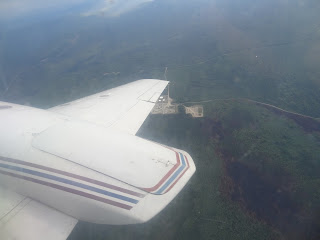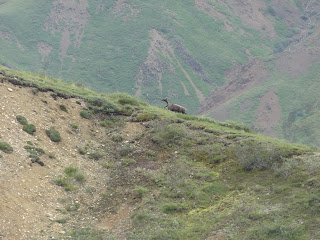The Dalton Highway is the only road to the North Shore of
Alaska. It runs 500-miles from Fairbanks
to Prudhoe Bay. There is one
restaurant/truck stop/air-field in the center of that stretch: Coldfoot,
Alaska. Even more amazing is the
community of Wiseman (pronounced Weiss-man). It is the only active community along the Dalton as it
winds between national parks and the Brooks Mountains. Wiseman is some 15 miles north of Coldfoot
and sixty miles above the Arctic Circle.
Gold was discovered there in 1892, although there is no active mining in
the Preserve today. Seven of us Fantasy
RV-ers flew up to see what life was like above the Arctic Circle.
N1-D3751 Flight Path
The Alaska Pipeline follows Dawson Road from the north shore
of Alaska to Fairbanks. The design and
maintenance of this pipeline to be compatible with continuously moving earth
above the permafrost, to be non-interfering with the movement of wildlife and
to protect the environment is an engineering masterpiece.
N2a-D3742 Pump Station emerging from the wing (my best shot)
We were able to observe a number of important features of
this land on the flights up and back.
Forest Fires are an important part of the ecological life cycle in the
arctic. Up here, they are started by
lightning (not man) and are allowed to burn naturally within the Preserve. While we were up, there were seven fires at
various stages of activity.
N2b-D3756 Smoke from some of the half-dozen on-going forest fires in
AK
The Yukon River travels 1996 miles to the Arctic Sea. This published number (1996) was probably
wrong the minute it was written down.
The river is continually changing course, exemplified by the wide range
of lakes and streams surrounding it as it widens and slowly changes its course.
N2c-D3758 Meandering Yukon River
The only bridge over this river in its entire 2000-mi stretch
appears along-side the Alaska Pipeline.
Unfortunately, I was not able to get a clear shot of it, but both
crossings are at a narrow region of the Yukon, just below the Arctic Circle.
N2d-D3779 the Pipeline (trust me, it crosses the Yukon above ground)
We were told that Fireweed is the first flowering plant to
backfill the burned areas of the forest.
Our prior experience was that fireweed grew in the cleared areas along
the roadsides. From the air, one gets a true impression of the proliferation of
Fireweed in nature. Numerous Fireweed
beds, ten to a-hundred square miles in expanse can be seen.
N2e-D3818 Fireweed begins to fill fire ravaged area nominally
2-years after the burn
Coldfoot began as an informal stopping place for
truckers. After years of operation, the
Government voted to allow one commercial operation at this midway point,
predicated on that promise that a particularly popular musher, and multiple
winner of the Iditarod be its proprietor.
Many of the materials for building the cafe were provided by the
truckers who used it, freeloading the materials and dropping them off as they stopped
by. Prominent in the restaurant is the
"Message Pole" they would (and still do) use to update their
colleagues.
N3-I3667 Cold Foot Message Pole
The town of Wiseman is still vital
with about half a dozen sourdough families and a few seasonal miners and
trappers.
N4a-D3792 Wiseman Welcome Sign
We were driven to Wiseman by a recent Zoology graduate who
was working in Alaska to hike and camp and pay off her student loans. She is shown here beside the local resident
who told us about the ecology and wildlife of the area. He, his wife and 2-year old daughter live off
the land year around. He traps, fishes
and hunts for game and livelihood. They
have generators and bottled gas, but their food comes from vegetable gardening
and hunting.
N4b-D3796 Guides Resident Sourdough and Graduate Zoologist
He moved there with his dad as a young boy and was there to
see the changes brought on by the road and the pipeline. In fact, he is on the boards of the Pipeline
and a couple of oil companies as a consultant on ecological impact of their
system.
N4c-D3798 One of the original cabins w/3rd roof (& solar
panels added at the back)
We took a short walk thru the village to see some of the
original buildings/dwellings that are still used and maintained today. Residences have cellars in which to store
vegetables year round. One buildings has
been set-aside as a sort of museum with photos of life in the north, examples
of animal pelts and by-products, and geological specimens.
N4d-D3799 Welcome Center and Museum
Shown below is a typical house, built close to the ground with thick log
walls for warmth. Just in front of the
house is a snow-shoe rabbit: a summer garden invader and year-round
resident. For protection from predators,
their coats are brown in the summer and white in the winter. Our attendant Zoologist informed us that the
snowshoe is a fecalvore. That is, in the wintertime, their diet is
woody plants and other matter that is difficult to digest in a single
pass. Their special technique to get all
the food energy from this diet is to run it thru a second time. They don't regurgitate the food to do this …
thus the term.
N4e-D3797 Wiseman scene, showing the uniquely adapted
snowshoe rabbit.
There is yet another invader to these bucolic environs. One such is shown below
N4f-D3800 Crain was here.
Trip Miles: 265 air-miles along the Dalton Highway (a Road
not Taken)
N5-i0467 Fairbanks to Wiseman - Flown not Driven



















































